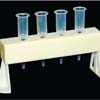 Improved methods for magnetic purification of malaria parasites and haemozoin.
Improved methods for magnetic purification of malaria parasites and haemozoin. Kim CC, Wilson EB, DeRisi JL.
Malar J. 2010 Jan Abstract: BACKGROUND: Malaria parasites generate free haem upon catabolism of host haemoglobin during their intraerythrocytic growth cycle. In order to minimize oxidative toxicity of the ferric iron, the free haem molecules are polymerized into the biomineral beta-haematin (commonly referred to as haemozoin). Haemozoin crystals are paramagnetic, and this property can be exploited for the purification of late stage parasites as they contain larger haemozoin crystals than early stage parasites and uninfected cells. Commercially available magnets that were originally developed for the purpose of antibody-mediated cell purification are widely used for this purpose. As these methods are not necessarily optimized for parasite purification, the relationship between magnetic field strength and the quantity and quality of yield during parasite purification was explored. METHODS: Inexpensive rare-earth neodymium magnets with commercially available disposable columns were employed to explore the relationship between magnetic field strength and recovery of free haemozoin and infected erythrocytes (iRBCs). RESULTS: Yields of free haemozoin increased nearly linearly with increasing magnetic field strength to the strongest fields tested (8,500 Gauss). Stronger magnetic fields also improved the recovery of iRBCs with no detrimental effects on parasite viability. An in-house constructed magnetic stand, built for $75 in materials, produced superior results when compared with much more expensive commercial products. CONCLUSIONS: Existing protocols for the magnetic purification of free haemozoin and iRBCs result in sub-optimal yields. Inexpensive high-strength neodymium magnets offer a better option, resulting in higher yields with no detrimental effects on parasite viability.
